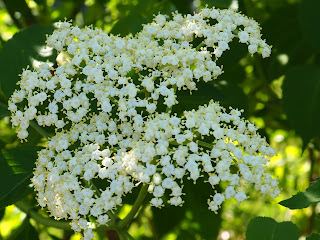Nature's Jewels: July at the Preserve
 |
| As you might predict, each flower on Asiatic dayflower (Commelina communis) only blooms during the morning for a single day. |
Asiatic dayflower (Commelina communis) was introduced to the United States from East Asia as an ornamental and similar to other non-native plants at the preserve, its beautiful appearance and invasive status leave me conflicted. At least its elegance must be a truth universally acknowledged. The brilliant blue color of the dayflower comes from a complex pigment called commelinin, formed from an interaction between anthocyanin and magnesium ions. The petals glisten in the sun because a few cells lacking pigment are scattered among the many containing commelinin. The yellow stamens are sterile but attract pollinators to the other--less showy but fertile--stamens of the flower.
While the Asiatic dayflower is short lived, other species will continue to glow in striking orange, purple, and scarlet hues for the last month of summer.
The scarlet, fragrant flowers of bee balm (Monarda didyma) primarily attract ruby-throated hummingbirds and butterflies. Due to the tubular structure of the flowers, pollinators with long proboscises are better able to reach the nectar. The blooms last up to 8 weeks, from July to September.
Jewelweed (Impatiens capensis) bejewels the preserve in bright orange. Dew or rain commonly beads up on the leaves, forming sparkling droplets which also might have inspired the common name. The decorative shape of the flower results from a modification of one of the sepals into a large, pouch-like structure with a long spur. After being visited by pollinators such as bees and hummingbirds, jewelweed produces fruit in the form of an elongated capsule. When ripe, the seed capsule explodes open at the slightest touch, dispersing the seeds several feet in all directions.
In addition to its showy orange flowers, jewelweed also has inconspicuous flowers near the base of the leaves which lack petals and fertilize themselves. The seeds produced by the cross-pollinated flowers have the evolutionary advantage of genetic diversity but the self-pollinated flowers can generate seed in a harsher environment. Increased light exposure and increased availability of soil nutrients allow the plant to handle the higher physiological cost of nectar production and insect pollination.
Interestingly, only the seed capsules produced in insect pollinated flowers can forcefully explode. The self-pollinated flowers give rise to closed seed pods, which drop to the soil immediately beneath the parent plant after they ripen. This allows the genetically identical plant to succeed in the same environment that favored the traits of the parent. Jewelweed's ability to self seed and form large colonies in moist, shaded areas allows it to compete successfully with garlic mustard (Allaria petiolata), an invasive described in the previous post.
 |
| The common name of bee balm (Monarda didyma) references the historical use of a resin derived from the leaves to soothe bee stings |
 |
| Bees, flies, butterflies, and hummingbirds are attracted to the dark orange spots on jewelweed (Impatiens capensis) flowers |
Although not as showy as jewelweed, the deciduous shrub white meadowsweet (Spiraea alba) fills an important ecological niche. A pink, orange, or yellow ring structure surrounds the five pistils in the center of the flower and lures insects to the nectaries. The shrub attracts an array of visitors including honeybees, native bees, wasps, ants, Syrphid flies, small butterflies, and beetles. Meadowsweet also offers habitat and nesting to songbirds such as Indigo Bunting, Grasshopper Sparrow, Song Sparrow, Red-Winged Blackbird, and American Woodcock, and is a host for the larvae of the Spring Azure butterfly.
 |
| White meadowsweet (Spiraea alba) flowers appear fuzzy due to their numerous long stamens |
 |
| Although equally inconspicuous, yarrow (Achillea millefolium) attracts bees, wasps, butterflies, and bees |
And now to circle back to the dilemma of the Asiatic dayflower--can the beauty of a plant be appreciated if it is invasive? Purple loosestrife (Lythrum salicaria) is notorious for its ability to escape cultivation and inundate wetlands. It eliminates native plants such as cattails, sedges, bulrushes, and ferns which provide food and nesting for wildlife and serve as stopover sites for migratory birds. Each mature plant can produce up to 2 million seeds each year. Its thick roots can send out 30 to 50 shoots, creating an extensive structure that displaces native vegetation. Yet, the showy flowers of purple loosestrife provide nectar for bumblebees and honeybees, gracing the preserve in a sea of purple.
 |
| A single rootstock of purple loosestrife (Lythrum salicaria) can produce 30 to 50 stems with flowers |
The European settlers who brought purple loosestrife to North America in the 1800s, for gardening and use in beekeeping, did not foresee that the ecological and the aesthetic might eventually come into conflict.



Comments
Post a Comment